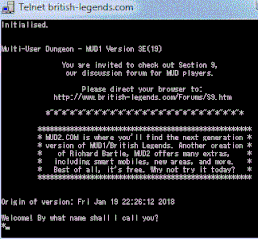머드 1
MUD1| 머드 1 | |
|---|---|
 | |
| 개발자 |
|
| 플랫폼 | 플랫폼에 의존하지 않음 |
| 풀어주다 | 1978 |
| 장르 | 공상 진흙 |
| 모드 | 멀티플레이어 |
Multi-User Dungeon(MUD1로 불리며 후속작인 MUD2, MUD 장르와 구별)은 최초의 MUD입니다.
역사
MUD는 1978년 Essex 대학의 Roy Trubshaw와 Richard Bartle에 의해 DEC [1][2]PDP-10으로 만들어졌습니다.트럽쇼는 트럽쇼가 [3][4]즐겼던 던전 변종 조크에 경의를 표하여 이 게임을 멀티 유저 던전이라고 명명했다.Zork는 Collarge Cave Adventure 또는 [5]ADVENT로 알려진 오래된 텍스트 어드벤처 게임에서 영감을 받았다.
MUD1은 도메인 고유의 프로그래밍 언어 MUDDL([6]Multi User Dungeon Definition Language)로 작성되었습니다.그것의 첫 번째 버전은 Richard Bartle과 Roy Trubshaw에 의해 BCPL에서 쓰여졌다.나중에 C++[7]로 포팅되어 [6]MIST와 같은 다른 MUD에서 사용되었습니다.
1980년 Roy Trubshaw는 BCPL(C의 전신)에서 MUD 버전 3을 개발하여 메모리 보존과 프로그램 [8]유지보수를 용이하게 했습니다.Essex의 동료 학생인 Richard Bartle은 오늘날까지 남아 있는 많은 장소와 퍼즐을 소개하며 게임 데이터베이스에 많은 작업을 했다.Roy Trubshaw는 그 해 말 Essex University를 졸업하고 MUD를 Richard Bartle에게 넘겨주었고, Roy Trubshaw는 계속해서 게임을 [9]개발했습니다.같은 해, Essex University가 내부 네트워크를 ARPANET에 [10]연결하면서 MUD1은 최초의 인터넷 멀티 플레이어 온라인 롤플레잉 게임이 되었다.
1983년 Essex University는 매일 밤 [11]2시에서 7시 사이에 British Telecom의 Packet Switch Stream 네트워크를 통해 DEC-10에 대한 원격 액세스를 허용했습니다.MUD는 전 세계 선수들에게 인기를 끌었고 몇몇 잡지들은 이 새로운 트렌드에 [12]대한 기사를 썼다.
1984년부터 1987년까지 외부 접근을 허용하는 몇 안 되는 기관 중 하나인 Dundee College of[13] Technology의 DEC-20에서 MUD가 개최되었습니다.
1984년 주로 Commodore 64 사용자를 위한 영국에 기반을 둔 네트워크인 Compunet은 MUD1을 라이센스하여 1984년 말부터 CompuNet이 [14]사용하던 DEC-10 플랫폼을 포기한 1987년까지 실행했습니다.
Trubshaw와 Bartle은 Multi-User Entertainment에서 협력하여 MUD2를 2세대 [15]MUD로 만들었습니다.1985년 Richard Bartle은 MUD2로 더 잘 알려진 MUD1 버전 4를 만들었습니다. 이 버전은 British [16]Telecom의 서비스로 운영될 예정이었습니다.
1987년, MUD1은 CompuServe에 의해 허가되었으며, 그는 리처드 바틀에게 '에섹스 MUD'로 더 잘 알려진 MUD1의 인스턴스를 폐쇄하도록 압력을 가했다.이로 인해 1987년 10월 MUD 계정이 삭제되었다.이로 인해 유사한 게임 플레이를 가진 MUD1의 파생 모델인 MIST는 에식스 대학 네트워크에서 유일하게 가동되는 MUD가 되었고, 광범위한 인기를 얻은 최초의 MUD 중 하나가 되었다.MIST는 1991년 초 이를 호스트한 기계인 PDP-10이 대체될 때까지 운영되었습니다.[17]
MUD1은 1999년 후반까지 British Legends라는 이름으로 운영되었으며 CompuServe의 Y2K 청소 [18]작업 중에 다른 소프트웨어와 함께 폐기되었습니다.
2000년 Viktor Toth는 MUD1의 BCPL 소스 코드를 C++로 고쳐 [19]British-legends.com에서 MUD2와 함께 오픈했습니다.
2014년 스탠퍼드 대학교는 MUD1의 [20]개발자들로부터 게임의 청사진을 재배포할 수 있는 허가를 받았다.
접수처
1993년 Computer Gaming World는 CompuServe에서 British Legends on CompuServe로 "마법을 강조한 전형적인 텍스트 기반 멀티 플레이어 역할 수행 게임"[21]이라고 칭했다.
레퍼런스
- ^ Sloane, Sarah(2000) 디지털 픽션: Ablex Publishing Corporation의 물질 세계에서의 스토리텔링 ISBN978-1-56750-482-8, 페이지 168
- ^ Slator, Brian M. et al "던전에서 교실까지:학습환경으로서의 MUD의 진화(Jain, Lakhmi C., Tedman, Raymond A. & Tedman, Debra K. (eds.) (2007) Springer, Springer, ISBN 9-783-1973).
- ^ Kevin Kelly, Howard Rheingold (1993). "The Dragon Ate My Homework". Wired. Vol. 1, no. 3.
In 1980, Roy Trubshaw, a British fan of the fantasy role-playing board game Dungeons and Dragons, wrote an electronic version of that game during his final undergraduate year at Essex College. The following year, his classmate Richard Bartle took over the game, expanding the number of potential players and their options for action. He called the game MUD (for Multi-User Dungeons), and put it onto the Internet.
{{cite magazine}}:author=범용명(도움말)이 있습니다. - ^ Richard Bartle (2003). Designing Virtual Worlds. New Riders. p. 741. ISBN 0-13-101816-7.
The "D" in MUD stands for "Dungeon" ... because the version of ZORK Roy played was a Fortran port called DUNGEN.
- ^ Tim Anderson; Stu Galley (1995). "The History of Zork". Archived from the original on 16 January 2009.
Zork was too much of a nonsense word, not descriptive of the game, etc., etc., etc. Silly as it sounds, we eventually started calling it Dungeon. (Dave admits to suggesting the new name, but that's only a minor sin.) When Bob the lunatic released his FORTRAN version to the DEC users' group, that was the name he used.
- ^ a b Bartle, Richard (1999). "MUDDL".
Many MUDDL databases were written by students at Essex University, the most well-known being 'Mist', 'Rock', 'Blud' and 'Uni' [...]
- ^ Bartle, Richard (2002). "Incarnations of MUD".
Viktor Toth had had a copy of the BCPL source code for MUD1 for some years, and decided that now was the time to do something with it. In a 9-day programming blitz over Christmas, he rewrote the BCPL MUDDL engine in C++ and opened it up alongside MUD2. The ex-CompuServe players gravitated there, where it now runs as a direct continuation of the defunct original BL incarnation.
- ^ Richard Bartle (1990). "Early MUD History".
The program was also becoming unmanageable, as it was written in assembler. Hence, he rewrote everything in BCPL, starting late 1979 and working up to about Easter 1980. The finished product was the heart of the system which many people came to believe was the 'original' MUD. In fact, it was version 3.
- ^ Eddy Carroll (1995). "MUD Timeline". Archived from the original on 3 May 2016. Retrieved 12 July 2008.
Roy graduates from Essex University, and Richard takes full control of the game, fleshing out the database and adding additional commands. A proper persona communication system is introduced, along with the concepts of points and wizards.
- ^ Mulligan, Jessica; Patrovsky, Bridgette (2003). Developing Online Games: An Insider's Guide. New Riders. p. 444. ISBN 1-59273-000-0.
1980 ... Final version of MUD1 completed by Richard Bartle. Essex goes on the ARPANet, resulting in Internet MUDs!
- ^ Eddy Carroll (1995). "MUD Timeline". Archived from the original on 3 May 2016. Retrieved 12 July 2008.
Essex University allows outside users to access its DEC-10 via BT's Packet Switch Stream network (PSS) during the normally idle period from 2am to 8am each night.
- ^ Richard Bartle (1995). "MUD Magazine Bibliography".
- ^ Richard Bartle (2004). Designing Virtual Worlds. ISBN 9780131018167.
Furthermore, it only ran on DEC-10, and although copies were sent to other institutions in the U.K., Sweden, and Norway, only two of these allowed outsiders access (Dundee Technical College and Oslo University).
- ^ Richard Bartle (1999). "CompuNet MUD".
The incarnation of MUD1 on the CompuNet network in the UK, the first commercial MUA in the world.
- ^ 'MUSE's Personal', mud.co.uk, 2010-12-18 취득
- ^ Richard Bartle (2002). "MUSE background".
A new version of the game, which came to be known as MUD2, was written in 1985 to be run as a service for British Telecom.
- ^ Michael Lawrie (2003). "Escape from the Dungeon".
October of 1987 was chaos. The MUD account was deleted, but the guest account on Essex University remained open. I guess it wasn't causing any trouble so they simply left it. ROCK, UNI and MUD all ran from the MUD account so they had gone but... MIST ran from a student account and it was still playable.
- ^ Richard Bartle (2007). "A Brief History".
Due in part to a fortuitous coincidence (MUD was written for the same DECSystem-10 computing platform that CompuServe used for its information service) MUD was licensed by CompuServe in the mid-1980s where it ran as a popular game until late 1999. It was eventually retired along with other software during CompuServe's Y2K cleanup efforts.
- ^ Richard Bartle (2002). "Incarnations of MUD".
Viktor Toth had had a copy of the BCPL source code for MUD1 for some years, and decided that now was the time to do something with it. In a 9-day programming blitz over Christmas, he rewrote the BCPL MUDDL engine in C++ and opened it up alongside MUD2. The ex-CompuServe players gravitated there, where it now runs as a direct continuation of the defunct original BL incarnation.
- ^ Simon Sharwood (2014). "Source code for world's first MUD, Essex Uni's MUD1, recovered". The Register.
The code has landed at Stanford University, which says it has secured permission to redistribute the game's blueprints from the authors Richard Bartle and Roy Trubshaw.
- ^ "A Survey of On-Line Games". Computer Gaming World. May 1993. p. 84. Retrieved 7 July 2014.



